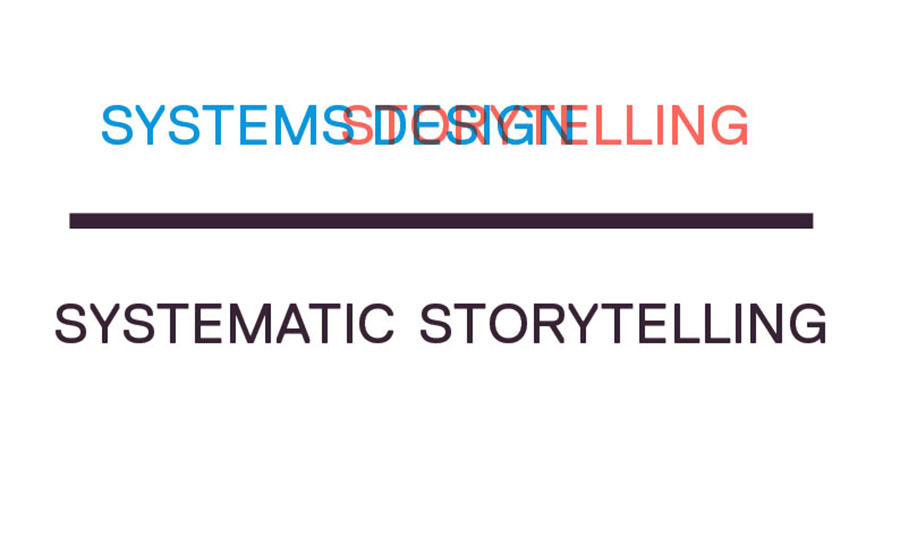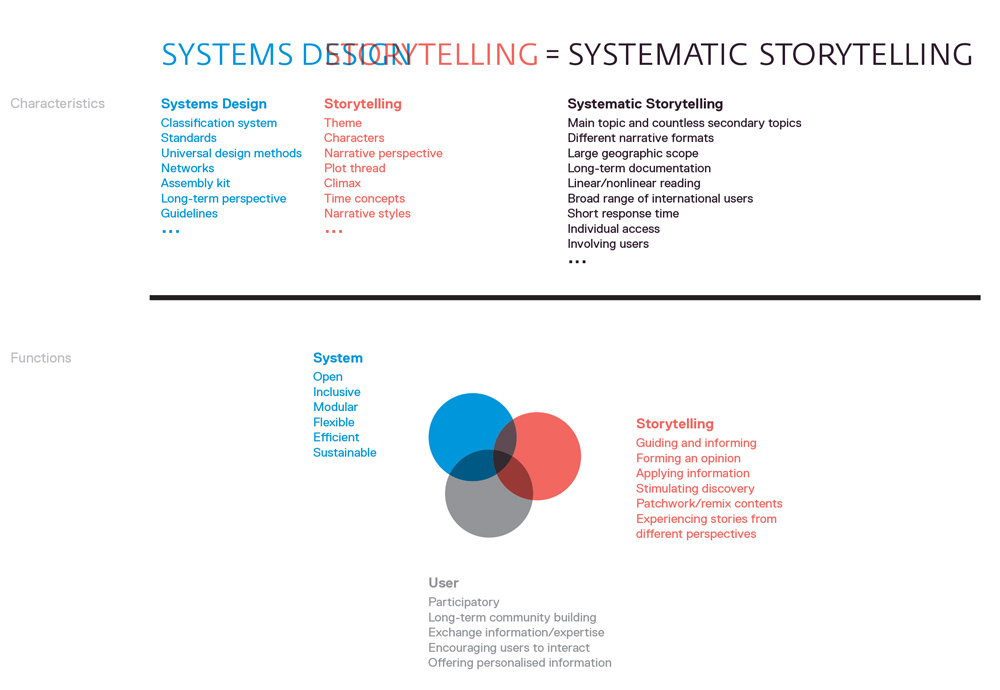Systematic Storytelling –
An information design method
for presenting complex storylines
Systematic Storytelling is an information design method that combines systems design and storytelling in order to meet a variety of user needs.
It is predestined for communicating storylines of high complexity:
– huge amount of data/material
– different narrative formats
– large time frame
– broad geographic scope
– nonlinear reading
– broad target group
– tools for involving users
– experimental navigation
…
Systematic Storytelling helps to build a system that makes complex relationships and connections accessible in an optimal and efficient way. It merges data-oriented, user-oriented, and story-oriented navigation into a ‘narrative system’. The focus lies on the content-related, narrative relationships between different parts in the system rather than on the individual parts.
Systematic Storytelling can be customised for a specific content, for example, from journalism, science or museum- and archive collections. The method can be used for digital applications (web platform, app, search engine, tool,..) and for print.
Systematic Storytelling can provide improvements in the following areas:
– improving the overal user-experience
– disclosing ‘all’ relevant information, including archived data
– improving navigation (overview, compass,…)
– applying inclusive design methods
– amplifying a user-centred approach
– motivating users to participate
– offering functions for remixing content
– optimising the maintainance of web platforms/digital applications
– introducing guidelines for maintainance and update
The method can be used for building a new system from scratch or for improving an existing one.
Research projects and assignments
In different research projects, I have often questioned common, linear narrative formats and ordering systems. These are insufficiently suitable for conveying multi-layered topics and complex contexts. For this reason, I started to mix information design methods (universal design principles, classification systems, standards, inclusive design methods) with storytelling formats and techniques. The user is offered, among others, a spectrum of different overviews, a range of filters and an individual access to a complex story. For this design of ‘narrative systems’, I have coined the term Systematic Storytelling.
I have already experimented with this method in my projects Designing universal knowledge and Amsterdam in documents.
My research project The Infinite Narrative served to further develop and lay down this information design method. In this project I examined to what extent a synthesis of systems design and storytelling can facilitate and enrich the communication of complicated, multi-layered content.
Part of the project was an analysis of more than 50 web platforms/digital applications and many interdisciplinary projects. Then, based on concept sketches, I designed systems in which data-oriented, user-oriented and story-oriented navigation are optimally intertwined.
This formed the basis for setting guidelines for the use of Systematic Storytelling.
In the meantime, I have developed concepts and storylines based on Systematic Storyline in various assignments:
For Follow the Money, a team of investigative journalists (Amsterdam, NL), I developed concepts to apply Systematic Storytelling to their web platform and app to improve navigation and user experience. In addition, I drafted new ideas for data-oriented and used-oriented features.
For Het Nieuwe Instituut (Rotterdam, NL), I developed a storyline based on Systematic Storytelling for their new collection platform. The goal is to encourage users to discover the complex National Collection for Dutch Architecture and Urban Planning in an experimental way.
Developing a storyline included ideas on how to address different user profiles. I also made concept sketches of wireframes showing the complexity of the overarching story and possible filters (data-, user-, experimental navigation, search). In addition I wrote all user stories, prepared a gap analysis and created templates and guidelines for the compilation of content.
The storyline and user stories were used as part of the briefing for the UI/UX designers and developers and as the starting point for the design of the user interface. Together with an editorial team from Het Nieuwe Instituut, I accompany the design and development up to the launch of the web platform (MVP).
If you want to tell a complex story (huge amount of data/ material, large time frame, broad geographic scope, nonlinear, involving users, experimental…) on a web platform, an app or in a publication, Systematic Storytelling can help to communicate it in the most effective and comprehensible way.
If you are interested in how Systematic Storytelling could improve your project, please contact me:
Gerlinde Schuller
studio(at)theworldasflatland.net
“If you want to tell a complex story on a web platform,
an app or in a publication, Systematic Storytelling
can help to communicate it in the most effective and
comprehensible way.”

